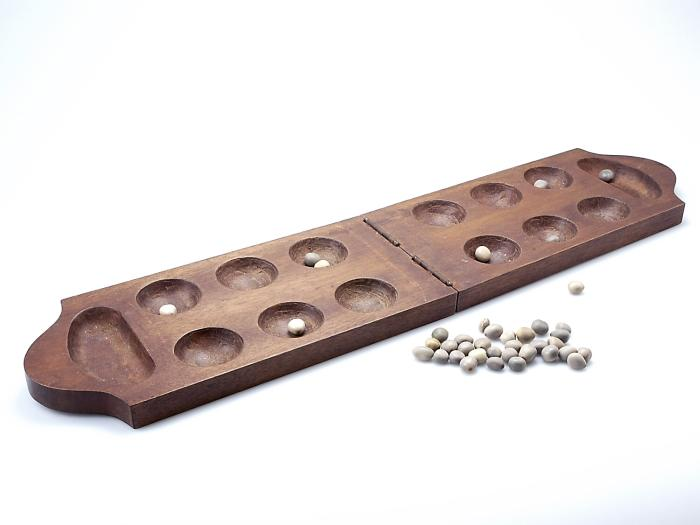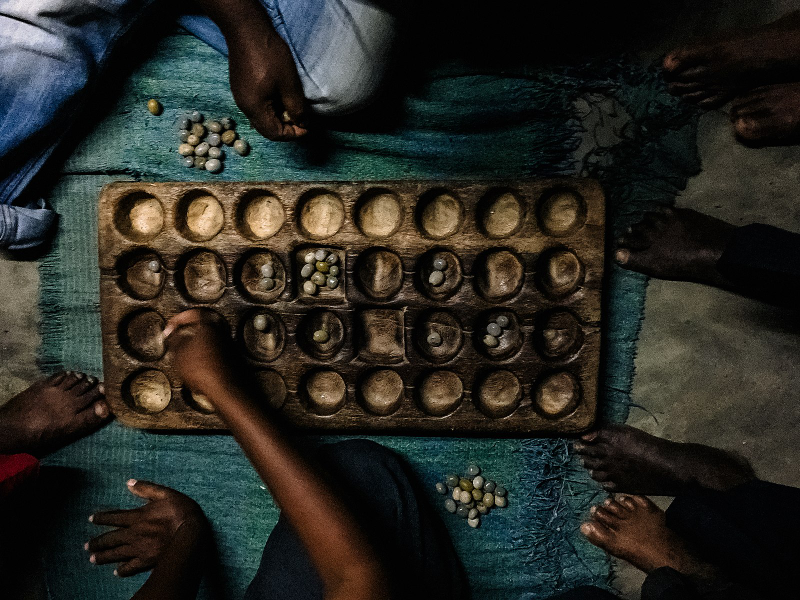Image Source: Wikimedia Commons
On a Sunny day, young men and women gather on the verandah, watching two of their colleagues in deep concentration as they engage in the game of Oware. Both players seem to be calculating their next move, while spectators give advice and banter. Who has what it takes to win the game?
Oware, also known as Mancala, is one of those games that will forever go down in the history of ancient games. It is one of the oldest and most popular traditional board games in Africa with a rich history, and it continues to be enjoyed by people of all ages across the continent. It is a strategy game for two or more players which requires 48 seeds (four per pit). It is played on a board with twelve small pits or hollows, arranged in two rows, with six pits on each player’s side. On the sides of the board are two larger holes used to store the seeds players capture during the match. The game requires concentration and calculation, else your opponent would win all your seeds.
This ancient African board game has been in existence for thousands of years and has captivated hearts and minds for generations, but how did it originate?
According to reports, its exact origin has been lost to history. However, Africa has always been considered its traditional home. Reports have it that it was invented by the Sumerians of ancient Africa several thousand years ago as a system of record keeping, having debit and credit entries. One side indicated money and goods received, and the other recorded sales or payments. Stone carvings of the game board surviving from ancient Egypt have been discovered in the roofing slabs of Kurma Temple at Thebes, at the summit of the great pylon at the entrance of the temple of Karnak, and Lukor temple.
In Ghana, carvings were found in the temple of Tarkora in Tanobuase in the Techniman district. There exists an Ashanti legend about how the name originated. It was said that a long time ago, a game of Oware between a man and a woman lasted so long, that they decided to get married to have more time to play. This incident is said to have given the game its Akan name of ‘Oware’, which means ‘being married’.
What different African countries call Oware
Oware has not only survived through the ages but has thrived, with unique variations and rules across different regions. Let’s take a look at the various names this ancient board game is called in different countries and regions.
In my region, we call it ise (Delta state, Nigeria) while the Yorubas call it Ayò, Ayoayo (Yoruba). Other climes have indigenous names for it such as Awalé (Ivory Coast), Wari (Mali), Warri (Caribbean), Wali (Dagbani), Ouri, Ouril or Uril (Cape Verde), Adji (Ewe), Nchọ/Ókwè (Igbo), Guithi (Kenya), Omweso (Uganda), Bao in East Africa and so many others.

Image Source: Tropenmuseum, part of the National Museum of World Cultures
How Oware is played
Just like the game has various names across different communities, there are also variations of Oware and specific rules. Different regions have developed their unique strategies and traditions, so there are hundreds of different ways to play.
The game begins with an equal number of seeds (four) in each of the twelve pits. Each player controls the six pits on their side of the board.
The first player, determined by mutual agreement, starts by choosing one of the pits on their side of the board and collecting all the seeds on it, leaving the hole empty. These seeds are then distributed one by one into the subsequent pits on the board during the sowing phase.
If the last seed is dropped into a pit that already contains seeds, the player must pick up the content of that pit and continue distributing them until the last pebble falls into an empty pit and their turn ends. The opponent then takes over.
If the last seed a player sows lands in a pit on their opponent’s side with two or three seeds, they capture those seeds. The captured seeds are then placed in the player’s “score” or “bank” pit, which is typically a larger pit to the right or left of their side of the board.
The goal is to capture more seeds than your opponent because the player with the highest number of captured seeds wins the match. The game is over when one of the players has captured more than 24 seeds or when both of the players have captured 24 seeds.
Cultural significance of Oware
Oware is more than just a game; it holds cultural and symbolic significance. Often played during social gatherings, family events, and special occasions, the game offers endless hours of social interaction and a glimpse into Africa’s rich cultural heritage. It is one way to pass down traditions and values to younger generations, promoting critical thinking and strategic planning. Players are encouraged to think ahead and make wise moves, reflecting the cultural value of foresight and planning.
In most cultures, the boards are uniquely constructed and decorated to reflect the cultural identity of the community. The patterns, symbols, and materials used in crafting the board can carry cultural significance.
Oware in modern times
This ancient board game has transitioned into modern times while retaining its cultural and social significance. It is played and enjoyed by people of various cultural backgrounds around the world.
The game has evolved in several ways with the advent of computers and the internet. There are computer versions of the game, where one can compete with other players in different parts of the world.





